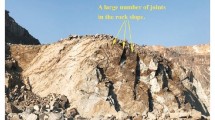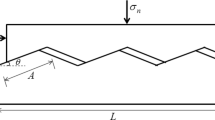Abstract
The paper presents the results of different methods of determining the roughness of joints in quartzites, metagreywackes and phyllites obtained from road cuts in central Portugal. The evaluation of the joint roughness coefficient (JRC) was carried out using graphical and analytical procedures. Differences were found between the JRC graphic and the JRC calculated, depending on the method used. The JRC calculated values obtained by the tilt tests and the Schmidt rebound hammer tests were compared to the JRC calculated values established from the rock joint shear tests. It is concluded that if JRC is to be used, it is essential to specify how it was established.
Résumé
Cet article présente les résultats de différentes méthodes de déterminer la rugosité des discontinuités trouvées dans des quartzites, métagrauwackes et schistes obtenus dans des talus des routes au centre de Portugal. L’évaluation du Coefficient de Rugosité du Joint Joint Roughness Coefficient (JRC) a été réalisée à travers des procédures analytiques et graphiques. Des différences entre le JRC graphique et le JRC calculé sont trouvées selon les méthodes employées. Les valeurs du JRC obtenues par les essais d’inclinaison (tilt tests) et les essais de dureté par marteau de Schmidt ont été comparées aux valeurs du JRC calculées à partir des essais de cisaillement des discontinuités. On conclu qu’il est fondamental d’indiquer comment le JRC a été établit.

















Similar content being viewed by others
References
Barton NR, Bandis SC (1990) Review of predictive capabilities of JRC–JCS model in engineering practice. In: Proceedings of the international conference on rock joints. Proc Int Conf Rock Joints 603–610
Barton NR, Choubey V (1977) The shear strength of rock joints in theory and practice. Rock Mech 10:1–54
Hack R (1998) Slope stability probability classification. In: ITC, International Institute for Geo-Information and Earth Sciences. Enschede, The Netherlands, 258 pp
Hack R, Price D, Rengers N (2003) A new approach of rock slope stability—a probability classification (SSPC). Bull Eng Geol Environ 62:167–184
Hoek E (2007) Practical rock engineering. Course notes, Hoek Corner. http://www.rocscience.com
International Society for Rock Mechanics—Turkish National Group (ISRM-TNG) (2007) The complete ISRM suggested methods for rock characterization, testing and monitoring: 1974–2006. In: Ulusay R, Hudson JA (eds) Ankara, Turkey, pp 165–173
Serviços Geológicos de Portugal (SGP) (1992) Carta geológica de Portugal—escala 1:500 000. Lisboa, Portugal
Author information
Authors and Affiliations
Corresponding author
Rights and permissions
About this article
Cite this article
Andrade, P.S., Saraiva, A.A. Estimating the joint roughness coefficient of discontinuities found in metamorphic rocks. Bull Eng Geol Environ 67, 425–434 (2008). https://doi.org/10.1007/s10064-008-0151-4
Received:
Accepted:
Published:
Issue Date:
DOI: https://doi.org/10.1007/s10064-008-0151-4
Keywords
- Joint Roughness Coefficient
- Discontinuities characteristics
- Tilt tests
- Rock joint shear tests
- Amplitude roughness
- Metamorphic rocks




